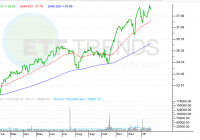Low Volatility ETFs Delivering Again In 2015
Summary The equities market is experiencing another bout of volatility. Low-volatility stock ETFs are outperforming the broader market. A closer look at low-volatility ETF strategies and sector tilts. The new year is still young, but investors have already been subjected to wild rides by major equity benchmarks. For example, the S&P 500 started 2015 on a downbeat note only to see all of those losses and then some erased by the end of last week, but a dismal showing this week has the benchmark U.S. index down nearly 3% year-to-date. Low volatility exchange-traded funds, including the PowerShares S&P 500 Low Volatility Portfolio ETF (NYSEARCA: SPLV ) and the iShares MSCI USA Minimum Volatility ETF (NYSEARCA: USMV ) are doing what they are supposed: outperform traditional benchmarks during times of market angst. The average year-to-date for SPLV and USMV is less than a half a percent, but that is clearly better than the 2.8% shed by the S&P 500. Notably, SPLV’s and USMV’s outperformance of the S&P 500 comes after the low volatility duo produced an average return of 18.7% last year, about 550 basis points better than the S&P 500 . “Within SPLV, seven of the ten largest holdings have an S&P Capital IQ Quality Ranking of B+ or above, with one with no ranking,” said S&P Capital IQ in a new research note. Dow components Wal-Mart (NYSE: WMT ) and Procter & Gamble (NYSE: PG ) are SPLV’s two largest consumer staples holdings. With an allocation of 16.5%, consumer staples is the third-largest sector weight in the ETF behind financials and utilities. P&G and Wal-Mart are also of the most reliable dividend growers among U.S. companies and although SPLV is not a dedicated dividend ETF, the fund has a trailing 12-month yield of almost 2.2%. That is 50 basis points above 10-year Treasuries, and SPLV pays its dividend monthly. “Though a company’s strong earnings and dividend record are not necessarily indicative of it having below-average volatility, our research has found many such companies have modest risk profiles,” said S&P Capital IQ. The research firm notes that SPLV’s exposure to financial services names is, not surprisingly, confined to lower beta fare such as insurance providers and real estate investment trusts (REITs). “In 2014, we saw defensive consumer staples, REITs, and utilities stocks perform relatively well as interest rates have declined and international economies such as Europe and Japan fall into recession. These stocks typically offer above-average dividend yields and are focused more on the U.S. where economic growth has been relatively impressive,” said S&P Capital IQ. As is often the case, there is a price to pay for playing defensive and it comes in the form of the higher valuations often ascribed to defensive sectors. Consumer staples and utilities are two of the most expensive sectors compared to the S&P 500. Add to that, S&P Capital IQ sees the bulk of SPLV’s 99 holdings as fairly valued, but the research maintains an overweight rating on the ETF. PowerShares S&P 500 Low Volatility Portfolio (click to enlarge)
